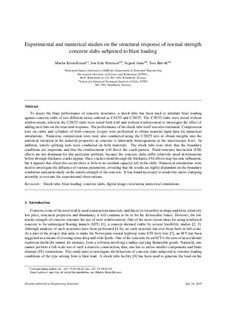| dc.contributor.author | Kristoffersen, Martin | |
| dc.contributor.author | Pettersen, Jon Eide | |
| dc.contributor.author | Aune, Vegard | |
| dc.contributor.author | Børvik, Tore | |
| dc.date.accessioned | 2018-09-19T12:24:55Z | |
| dc.date.available | 2018-09-19T12:24:55Z | |
| dc.date.created | 2018-07-24T15:50:05Z | |
| dc.date.issued | 2018 | |
| dc.identifier.issn | 0141-0296 | |
| dc.identifier.uri | http://hdl.handle.net/11250/2563465 | |
| dc.description.abstract | To assess the blast performance of concrete structures, a shock tube has been used to simulate blast loading against concrete slabs of two different mixes ordered as C45/55 and C20/25. The C45/55 slabs were tested without reinforcement, whereas the C20/25 slabs were tested both with and without reinforcement to investigate the effect of adding steel bars on the structural response. The performance of the shock tube itself was also evaluated. Compression tests on cubes and cylinders of both concrete recipes were performed to obtain material input data for numerical simulations. Numerous compression tests were also conducted using the C20/25 mix to obtain insights into the statistical variation in the material properties as concrete is inherently heterogeneous at the macroscopic level. In addition, tensile splitting tests were conducted on both materials. The shock tube tests show that the boundary conditions are important and that the reinforcement will direct the crack pattern. Fluid-structure interaction (FSI) effects are not dominant for this particular problem, because the concrete slabs suffer relatively small deformations before through-thickness cracks appear. Once cracks extend through the thickness, FSI effects may become influential, but it appears that when this occurs there is little or no residual capacity left in the slabs. Numerical simulations were used to investigate the influence of various parameters, revealing that the results are highly dependent on the boundary conditions and particularly on the tensile strength of the concrete. It was found necessary to model the entire clamping assembly to recreate the experimental observations. | nb_NO |
| dc.language.iso | eng | nb_NO |
| dc.publisher | Elsevier | nb_NO |
| dc.rights | Attribution-NonCommercial-NoDerivatives 4.0 Internasjonal | * |
| dc.rights.uri | http://creativecommons.org/licenses/by-nc-nd/4.0/deed.no | * |
| dc.title | Experimental and numerical studies on the structural response of normal strength concrete slabs subjected to blast loading | nb_NO |
| dc.type | Journal article | nb_NO |
| dc.type | Peer reviewed | nb_NO |
| dc.description.version | acceptedVersion | nb_NO |
| dc.source.pagenumber | 242-255 | nb_NO |
| dc.source.volume | 174 | nb_NO |
| dc.source.journal | Engineering structures | nb_NO |
| dc.identifier.doi | 10.1016/j.engstruct.2018.07.022 | |
| dc.identifier.cristin | 1598533 | |
| dc.relation.project | Statens Vegvesen: Ferjefri E39 | nb_NO |
| dc.relation.project | Norges forskningsråd: 237885 | nb_NO |
| dc.description.localcode | © 2018. This is the authors’ accepted and refereed manuscript to the article. Locked until 27.7.2020 due to copyright restrictions. This manuscript version is made available under the CC-BY-NC-ND 4.0 license http://creativecommons.org/licenses/by-nc-nd/4.0/ | nb_NO |
| cristin.unitcode | 194,64,45,0 | |
| cristin.unitname | Institutt for konstruksjonsteknikk | |
| cristin.ispublished | false | |
| cristin.fulltext | postprint | |
| cristin.qualitycode | 2 | |

